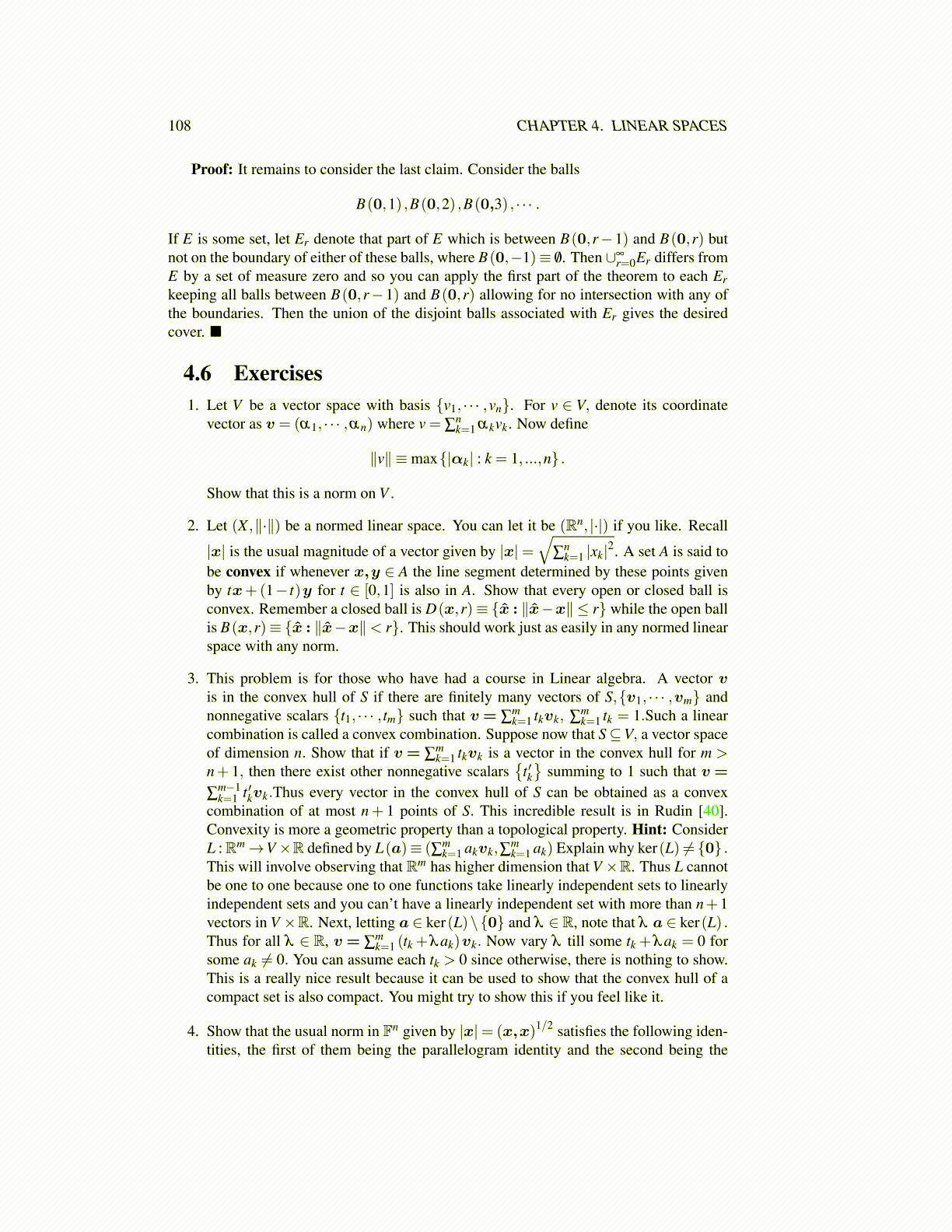
108 CHAPTER 4. LINEAR SPACES
Proof: It remains to consider the last claim. Consider the balls
B(0,1) ,B(0,2) ,B(0,3) , · · · .
If E is some set, let Er denote that part of E which is between B(0,r−1) and B(0,r) butnot on the boundary of either of these balls, where B(0,−1)≡ /0. Then ∪∞
r=0Er differs fromE by a set of measure zero and so you can apply the first part of the theorem to each Erkeeping all balls between B(0,r−1) and B(0,r) allowing for no intersection with any ofthe boundaries. Then the union of the disjoint balls associated with Er gives the desiredcover. ■
4.6 Exercises1. Let V be a vector space with basis {v1, · · · ,vn}. For v ∈ V, denote its coordinate
vector as v = (α1, · · · ,αn) where v = ∑nk=1 αkvk. Now define
∥v∥ ≡max{|αk| : k = 1, ...,n} .
Show that this is a norm on V .
2. Let (X ,∥·∥) be a normed linear space. You can let it be (Rn, |·|) if you like. Recall
|x| is the usual magnitude of a vector given by |x|=√
∑nk=1 |xk|2. A set A is said to
be convex if whenever x,y ∈ A the line segment determined by these points givenby tx+(1− t)y for t ∈ [0,1] is also in A. Show that every open or closed ball isconvex. Remember a closed ball is D(x,r)≡ {x̂ : ∥x̂−x∥ ≤ r} while the open ballis B(x,r)≡ {x̂ : ∥x̂−x∥< r}. This should work just as easily in any normed linearspace with any norm.
3. This problem is for those who have had a course in Linear algebra. A vector vis in the convex hull of S if there are finitely many vectors of S,{v1, · · · ,vm} andnonnegative scalars {t1, · · · , tm} such that v = ∑
mk=1 tkvk, ∑
mk=1 tk = 1.Such a linear
combination is called a convex combination. Suppose now that S⊆V, a vector spaceof dimension n. Show that if v = ∑
mk=1 tkvk is a vector in the convex hull for m >
n+ 1, then there exist other nonnegative scalars{
t ′k}
summing to 1 such that v =
∑m−1k=1 t ′kvk.Thus every vector in the convex hull of S can be obtained as a convex
combination of at most n+ 1 points of S. This incredible result is in Rudin [40].Convexity is more a geometric property than a topological property. Hint: ConsiderL :Rm→V×R defined by L(a)≡ (∑m
k=1 akvk,∑mk=1 ak) Explain why ker(L) ̸= {0} .
This will involve observing that Rm has higher dimension that V ×R. Thus L cannotbe one to one because one to one functions take linearly independent sets to linearlyindependent sets and you can’t have a linearly independent set with more than n+1vectors in V ×R. Next, letting a ∈ ker(L)\{0} and λ ∈ R, note that λ a ∈ ker(L) .Thus for all λ ∈ R, v = ∑
mk=1 (tk +λak)vk. Now vary λ till some tk +λak = 0 for
some ak ̸= 0. You can assume each tk > 0 since otherwise, there is nothing to show.This is a really nice result because it can be used to show that the convex hull of acompact set is also compact. You might try to show this if you feel like it.
4. Show that the usual norm in Fn given by |x|= (x,x)1/2 satisfies the following iden-tities, the first of them being the parallelogram identity and the second being the